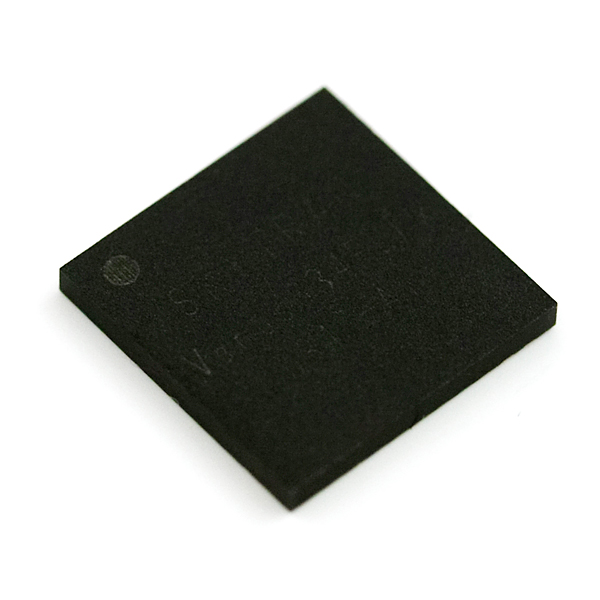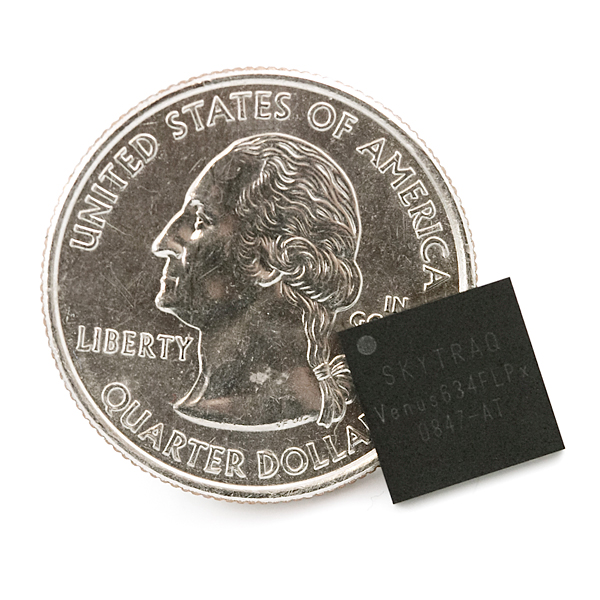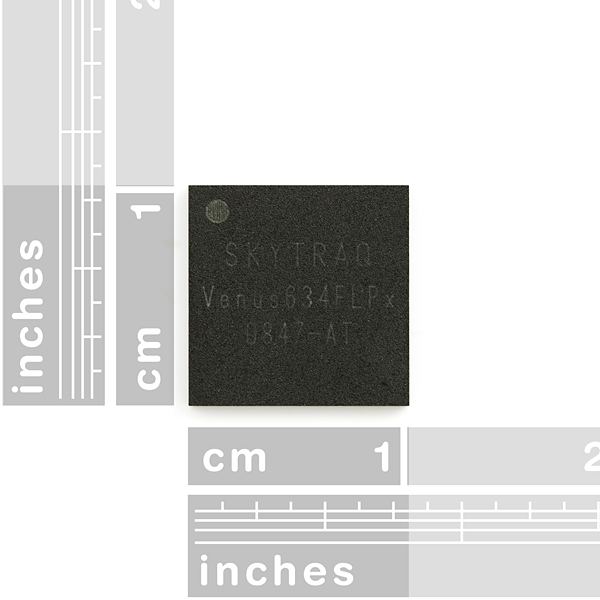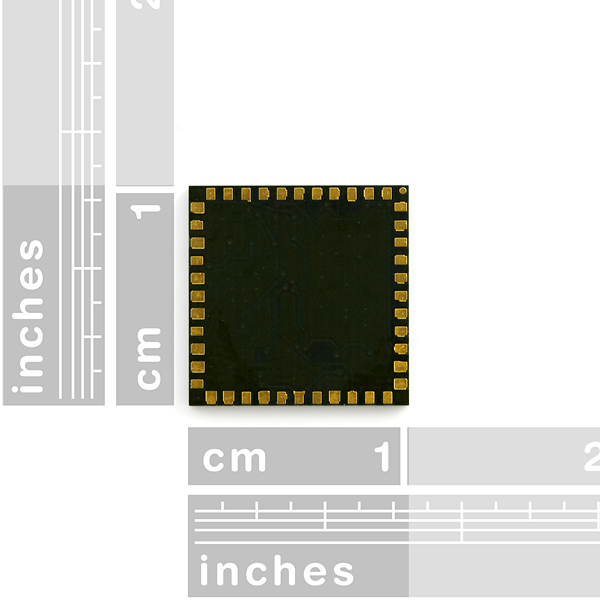GPS Module - Venus638FLPx-L 20Hz (14 Channel)
Venus638FLPx is a high performance, low cost, single chip GPS module targeting mobile consumer and cellular handset applications. It offers very low power consumption, high sensitivity, and best in class signal acquisition and time-to-first-fix performance.
Venus638FLPx contains all the necessary components of a complete GPS module, includes 1.2dB cascaded system NF RF front-end, GPS baseband signal processor, 0.5ppm TCXO, 32.768kHz RTC crystal, RTC LDO regulator, and passive components. It requires very low external component count and takes up only 100mm2 PCB footprint.
Not sure which GPS module is right for you? Check out our GPS Buying Guide!
Note: According to the manufacturer's specifications, the IC requires a 24 hour pre-bake at 125C before SMD mounting in order to prevent issues with moisture .
Replaces:GPS-09060
- -148dBm cold start sensitivity
- -165dBm tracking sensitivity
- 29 second cold start TTFF
- 3.5 second TTFF with AGPS
- 1 second hot start
- 2.5m accuracy
- Multipath detection and suppression
- Jamming detection and mitigation
- SBAS (WAAS / EGNOS) support
- 67mW full power navigation
- Works directly with active or passive antenna
- Internal flash for optional 75K point data logging
- Supports external SPI flash memory data logging
- Complete receiver in 10mm x 10mm x 1.3mm size
- Contains LNA, SAW Filter, TCXO, RTC Xtal, LDO
- 10 x 10 x 1.3mm, LGA69 package
GPS Module - Venus638FLPx-L 20Hz (14 Channel) Product Help and Resources
Core Skill: Soldering
This skill defines how difficult the soldering is on a particular product. It might be a couple simple solder joints, or require special reflow tools.
Skill Level: Competent - You will encounter surface mount components and basic SMD soldering techniques are required.
See all skill levels
Core Skill: Programming
If a board needs code or communicates somehow, you're going to need to know how to program or interface with it. The programming skill is all about communication and code.
Skill Level: Rookie - You will need a better fundamental understand of what code is, and how it works. You will be using beginner-level software and development tools like Arduino. You will be dealing directly with code, but numerous examples and libraries are available. Sensors or shields will communicate with serial or TTL.
See all skill levels
Core Skill: Electrical Prototyping
If it requires power, you need to know how much, what all the pins do, and how to hook it up. You may need to reference datasheets, schematics, and know the ins and outs of electronics.
Skill Level: Experienced - You will need to consult a datasheet for calculations to determine a components output format, linearity, and do a little math to get what you need. You will be using a datasheet or schematic beyond basic pinouts.
See all skill levels
Comments
Looking for answers to technical questions?
We welcome your comments and suggestions below. However, if you are looking for solutions to technical questions please see our Technical Assistance page.
Customer Reviews
5 out of 5
Based on 1 ratings:
2 of 2 found this helpful:
Solid GPS chip
Using it in an autonomous sail boat project. Easy to setup and integrate. The low power standby is clutch.





When can we expect to see a dev board with this chip on it now that the Venus634 is retired?
Agree, very eager for a dev board like the GPS-09133.
24 hours at 125C? That can't be right. I don't think anyone would want to prebake for that long if they were doing production.
Atmel, for instance, ships their moisture sensitive parts in sealed bags to prevent that issue. I don't recall the atmel part number (attiny24 maybe), but every one I received was individually vacuum packed with an indicator card so you'd know if you needed to prebake it or not. Even so, the prebake period is fairly short.
Just curious...
The entire statement in the datasheet is:
OK, but note that in the part description you write 125C, not 25C.
Sorry, I mangled the quote (now fixed), it does state 125C in the datasheet.
The photos of your IC and the IC in the datasheet look different. Could you please clairify and let us know which one is correct and which pinout to use. Thanks.
You are probably right. The photo is of a LGA44 package (possibly the older Venus634FLPx) and this is a LGA69 package.
The Venus638FLPx-L is a drop-in replacement of the Venus634FLPx, but some new functions require use of the new pins.
These are older photos of the 634, we'll update them soon. The 638 has the same footprint as the 634 with the addition of BGA-style pads beneath the chip. Use the layout in the datasheet.
Do you have an eagle footprint or any recommendations on accessing these pads underneath?
The footprint is in the SFE library (VENUS638FLPX-L), but it hasn't been proven yet.
Do you think adding vias underneath would be able to access these pads? Sorry but I'm just trying to make my own GPS logger...
Two things: 1. yes, vias would be the only way to access the pads beneath the chip. 2. After talking with the manufacturer, it appears that the additional ports underneath the chip are only enabled if you write custom code for the chip. The stock firmware does not access them.
Does anyone know if it's possible to communicate with this receiver via SPI or I2C instead of UART?
Hi everyone. I have a question about active antenna. In datasheet is shown that active antenna is hooked up to power supply 3.3V and connected to input pin RFIN pin. I need to use an active antenna with power supply 5V. Is the RFIN pin 5V tolerant?
I'm having trouble sending any commands to my receiver. I am using the FTDI serial converter, and connecting it to the board I can receive all the NMEA messages and see it acquire satellites and such, but whenever I try and send a command (like reset, or query version or whatever) it just hangs for a while then says it timed out. Any ideas?
Anyone have some example C code to send a binary command to the receiver?
Thanks
I want to know if the chip is supplied with a preloaded firmware. If not, how can I download the firmware onto the chip?
Has anyone been able to use the internal flash for data logging?? I have been trying to find any documentation about it but have not been very successful so far. Any help would be appreciated.
We're working on a tutorial for this, but in the meantime see the information at our Venus Breakout Board product page. Basically you use the GPS Viewer / Configuration Software to first load the internal logging firmware onto the Venus chip, and then use the same software to configure, start / stop, and download the internal log.
What is a suitable evalution board for this module?
The datasheet says that it is a 65 channel architecture, which is different from the product description. is there something that needs to be clarified
Does SF offer prebake services for those of us who are just using bench-top hot air stations to work with these?